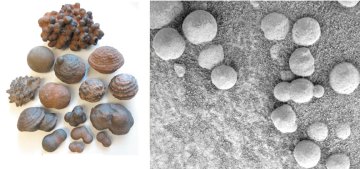Small iron oxide nodules recently found on Mars by NASA’s Opportunity rover could have a geological kinship with similar spherules within certain sandstones of the Southwest, suggest scientists who are analyzing the terrestrial material.

Early this year, scientists announced the discovery of tiny, spherical grains of hematite, a type of iron oxide, in some Martian sediments. Those spherules were dubbed blueberries because their distribution within the sediments reminded one of the scientists of blueberries in a muffin. The hematite blueberries provided one of several lines of evidence that suggest water once flowed on the Red Planet (SN: 3/6/04, p. 147: Red Planet Makes a Splash: Rover finds gush of evidence for past water). Although many of the Martian blueberries examined by NASA’s Opportunity rover were still embedded in rocks, erosion had freed others.
The same type of iron oxide concretions form within some Utah sandstones, says Marjorie A. Chan, a geologist at the University of Utah in Salt Lake City. These terrestrial nodules come in spherical, ovoid, and lumpy shapes and can measure 20 centimeters or more across, while their Martian analogues are typically spherical and range up to only 5 millimeters in diameter.
The Utah nodules probably formed when a stream of groundwater rich in dissolved minerals, including iron, encountered chemical conditions that caused the iron to precipitate. Some of these nodules have a homogeneous internal structure, says Chan, while others appear to have growth rings or an outer rind. These features suggest that the concretions may have grown in episodes rather than all at once, she notes. Chan and her colleagues describe the Utah nodules in the June 17 Nature.
The size and spacing of hematite nodules within Utah sandstones depend on many factors, including the salinity, pH, flow path, and flow rate of groundwater that’s coursing through the porous rock. Previous lab experiments suggested that the presence of bacteria can speed nodule formation, says Chan. Detailed chemical and microscopic analyses of the terrestrial nodules may shed light on how they and their Martian counterparts formed.
However, because a wide range of conditions can produce such lumps, additional evidence from Martian rocks will be needed to pin down exactly how the Red Planet’s blueberries formed, Chan cautions.
Mineral concretions such as the blueberries can be valuable indicators of sedimentary processes, environmental conditions, and ancient climates, says David C. Catling of the University of Washington in Seattle.
Detailed analyses of the sediments encasing the Martian blueberries would probably be even more revealing, but Opportunity isn’t equipped for such investigations. Therefore, Catling comments in the same issue of Nature, Opportunity’s landing site would be a good candidate for a future mission that can return samples to Earth.






